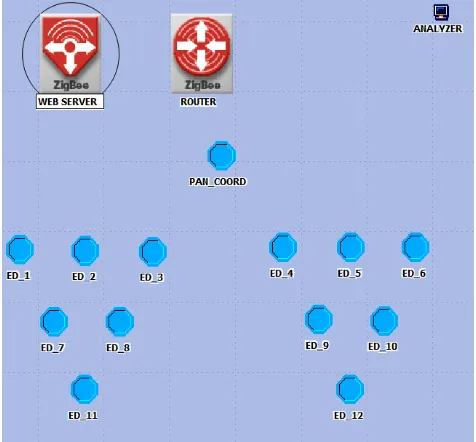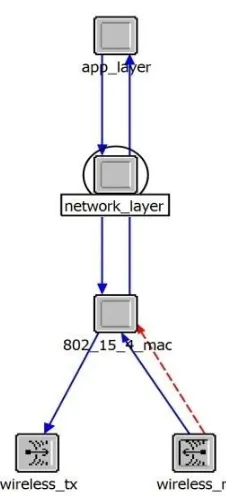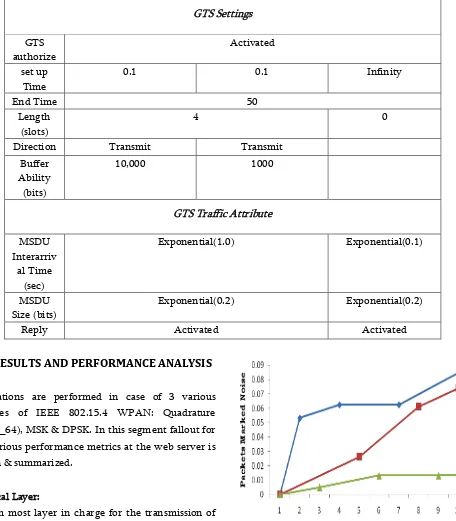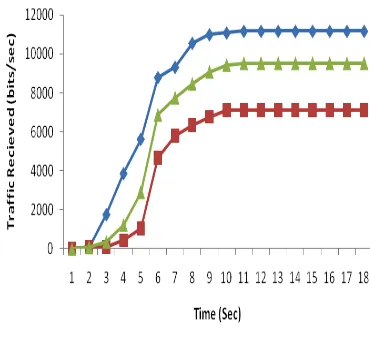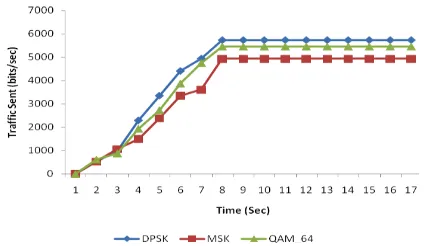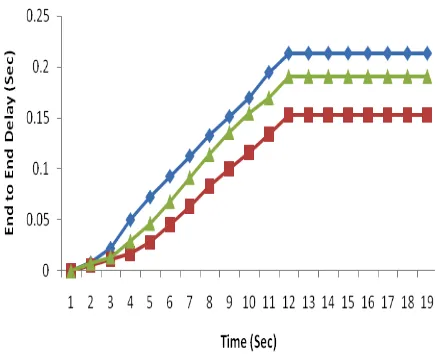International Journal of Scientific Research in Computer Science, Engineering and Information Technology
© 2018 IJSRCSEIT | Volume 3 | Issue 3 | ISSN : 2456-3307
Performance Analysis with Modulations in Web Server of
IEEE 802.15.4 for WSNs
Ashok K Yadav *1, A K Solanki2, Sukhvinder S Bamber3
*1 Computer Science & Engineering, BIET, Jhansi, Uttar Pradesh, India 2 Computer Science & Engineering, BIET, Jhansi, Uttar Pradesh, India
3 Computer Science & Engineering. Panjab University SSG Regional Centre, Punjab, India
ABSTRACT
The major purpose of this paper is to study and find effects of modulation techniques namely MSK, DPSK and QAM_64 on performance of IEEE 802.15.4 which is predefined mechanism in case of Wireless Sensor Network (WSNs). Further, modulation techniques are studied & compared on the basis of various parameters like collisions, end-to-end delay, traffic sent & traffic received. Parameters at different layers i.e. physical, MAC layer and application layer are considered and the results were analyzed. Overall, depending upon the expectations from system there is a tradeoff between the three modulation scenarios.
Keywords: Wireless Sensor Networks (WSNs), MSK, DPSK, Wireless Personal Area Network (WPAN), and QAM_64
I.
INTRODUCTION
Wireless sensor networks are experiencing an exponential growth and are likely to follow the trend in near future as well. The increasing number of nodes and the services being expected from WSNs need continuous improvements in the performance of these networks, in form of higher throughput, low energy consumption, low value for BER and delays etc.
The digital modulation techniques can help us in boosting the performance of these networks. One can select the kind of modulation depending upon the kind of requirements one’s network demands, as there is not any single correct choice which applies to all the cases. The differences in channel traits, choices of certain parameters and expected performance shall help make an informed decision for modulation scheme to be followed. The IEEE 802.15.4 standard used for WSN applications intends to give less cost & low power wireless sensor association between various mobile as well as stationary sensor nodes.
Various researchers have worked on making the IEEE 802.15.4 standard efficient based on various parameters. Some researchers have worked on possible radio configuration in permanent broadband wireless networks with focus on power efficient (Coudert et al. 2010).Some have estimated SNR for Orthogonal Frequency Division Multiplexing (OFDM) systems (Wang & Zhang, 2010). While, few researchers utilized SNR in order to intellect spectrum in radio networks (Wu et al. 2010). Moreover, researchers had even projected SNR using presumptive information (Nie et al. 2009). Coupling of load for different applications has also been tried (Negra et al. 2008) and some have studied load balancing for wireless mesh networks (Bejerano et al. 2007).
of different modulation techniques (MSK, DPSK and QAM_64) has been done, so as to find out the aptness of the system depending upon the kind of device. The device may be a fully functional or a reduced functional device. We considered parameters for making comparison.
One of the requirements of the graduate Science, Engineering and Technology courses is that you conduct research and write a research paper on some aspects of software engineering. The paper may present original work, discuss a new technique, provide a survey and evaluation of recent work in a given area, or give comprehensive and taxonomic tutorial information. The paper must emphasize concepts and the underlying principles and should provide authentic contribution to knowledge. If your paper does not represent original work, it should have educational value by presenting a fresh perspective or a synthesis of existing knowledge. The purpose of this document is to provide you with some guidelines. You are, however, encouraged to consult additional resources that assist you in writing a professional technical paper.
Before submitting your final paper, check that the format conforms to this template. Specifically, check the appearance of the title and author block, the appearance of section headings, document margins, column width, column spacing and other features.
The organization of this document is as follows. In Section 2 (Methods and Material), I’ll give detail of any modifications to equipment or equipment constructed specifically for the study and, if pertinent, provide illustrations of the modifications. In Section 3 (Result and Discussion), present your research findings and your analysis of those findings. Discussed in Section 4(Conclusion) a conclusion is the last part of something, its end or result.
II.
SYSTEM DESCRIPTION
OPNET Modeler 14.5 along with open-zb simulation model were utilized for building 802.15.4 WSNs. Figure 1 depicts the view for 3 scenarios: MSK, DPSK & QAM_64. All three scenarios contain contains one web server, one router, 1 PAN Coordinator, 1 analyzer & twelve end devices all are GTS activated. WEB SERVER is a FFD which receives the sensed data through the ROUTER. PAN_COORD (PAN Coordinator) is a FFD that handles the operation of whole network. Further there exists a device called ANALYZER, which gathers the performance statistics of the network as a whole and of the individual objects in the network. EDs (End devices) are the permanent stations which converse with the PAN manager in peer to peer manner. All three scenarios are identical in each respect except the modulation schemes.
Figure 1. PAN Coordinator model
Figure 2(a). Web Server Node model
Figure 2(b): PAN Cordinator & End devices with node model
Figure 2 (c): Analyzer
A node model for Web Server has four layers: PHY, MAC, NETWORK and APP layer whereas, a node structure for GTS ends device & PAN Coordinator has three layers: PHY, MAC and APL layers. A node structure by the analyzer contains sink & radio receiver.
III.
ATTRIBUTE SETTING
Performance of IEEE 802.15.4 for WSNs with appropriate values to the attributes of different types of devices is dependent on the modulation format used. The attributes that significantly affects efficiency of IEEE 802.15.4 for WSNs are: GTS traffic, CSMA/CA, WPAN settings etc. as shown in the table 1:
Table 1. Attribute settings for Web Server, PAN Coordinator, GTS End Device in BPSK, MSK & QAM_64 Schemes.
Attributes PAN Coordinator (PAN_COORD)
GTS Enabled End Device (ED)
WEB SERVER
Modulatio n
DPSK MSK QAM_6 4
DPSK MSK QAM_6 4
DPSK MSK QA M_6
4
Acknowledged Traffic Source
End Point MAC Address
Web Server (PAN Coordinator)
PAN Coordinator All Nodes
Interarriv al Time
(sec) MSDU dimension
(bits)
Exponential(0.2) Exponential(0.2) Exponential(912)
Launch Time (sec)
0.1 0.1 1.0
End Time (sec)
50
Non-acknowledged Traffic Source
MSDU Interarriv
al Time (sec)
Exponential(1.0) Exponential(1.0) Exponential(1.0)
MSDU Size (bits)
Exponential(0.2) Exponential(0.2) Exponential(912)
Initiation Time (sec)
0.1 0.1 1.1
End Time (sec)
50
CSMA/CA Parameters
Greatest Back-off Number
4
Least amount Backoff Exponent
3
IEEE 802.15.4
Machine Mode
PAN coordinator End Device
Medium Access Control
Address
1 Self Assigned
WPAN Settings
Beacon Order
13 13 6
Superfram e Order
7 0
PAN ID 0
Logging
Activate Logging
GTS Settings
GTS authorize
Activated
set up Time
0.1 0.1 Infinity
End Time 50
Length (slots)
4 0
Direction Transmit Transmit
Buffer Ability
(bits)
10,000 1000
GTS Traffic Attribute
MSDU Interarriv
al Time (sec)
Exponential(1.0) Exponential(0.1)
MSDU Size (bits)
Exponential(0.2) Exponential(0.2)
Reply Activated Activated
IV.
RESULTS AND PERFORMANCE ANALYSIS
Simulations are performed in case of 3 various schemes of IEEE 802.15.4 WPAN: Quadrature (QAM_64), MSK & DPSK. In this segment fallout for the various performance metrics at the web server is shown & summarized.
Physical Layer:
Bottom most layer in charge for the transmission of data from the starting point to the immediate next destination. Also responsible for the other functions like: modulations at the transmitter, receiver etc.
4.1 Packets Marked Noise (Radio Receiver)
The proportion of data-packets that are marked noise to the total number of packets arriving at a receiver of the web server.
Figure 3. Packets Marked Noise at Radio Receiver of Web Server
Therefore, it is concluded that if packets marked noise are to be considered, then QAM_64 should be preferred as packets marked noise are minimum incase of QAM_64.
Collision Status (Radio Receiver)
Collision Status is the amount of collisions taking place at the radio receiver of the web server while receiving the data.
Figure 4. Collision Status at Radio Receiver of Web Server
The Figure 4 depicts the 0.001056, 0.001056 and 0.000704 collisions that the radio receiver respectively. Moreover, observation is also made that collisions occurs more for DPSK and MSK while the least in case of QAM_64. This is due to the fact that QAM_64 hikes the performance of communication by using together the amplitude & phase variations. QAM helps in making the system immune to noise as it allows the signal vectors to differ in both phase and amplitude. Therefore, if the collision status at the radio receiver of web server is to be considered, then in that case, QAM_64 should be favored.
MAC Layer:
Layer that lies on the apex of the physical layer is the MAC layer. It is responsible for accessing the medium for the transmitting the data from source to
destination. Also, it is responsible for error detection and correction.
4.3Control Traffic Received
Control Traffic received is the quantity of management traffic received per unit time by the MAC layer of web server either from the physical layer or from the network layer in addition to the actual data to be transmitted.
Figure 5: Control traffic recieved
Figure 5 depicts that the control traffic received at the MAC layer of Web Server is: 11176, 7128 and 9504 bits/sec respectively. It is noticed that the traffic received is maximum in case of DPSK while it is minimum in case of MSK. It may be attributed to the fact that DPSK is a Differential Phase Shift Keying modulation scheme which is able to modulate 40 Gbit/sec and also each transmission in DPSK depends upon the previous. Therefore, if the control traffic received on the MAC layer of web server is to be taken into consideration then the DPSK modulation scheme should be preferred.
4.4Control Traffic Sent
Figure 6. Control Traffic Sent from MAC Layer of Web Server
Figure 6 shows that the control traffic sent in case of DPSK, MSK and QAM_64 is: 5720, 4928 and 5456 bits/sec respectively from the MAC layer of web server. It is observed that the maximum control traffic is sent in case of DPSK while minimum is sent in case of MSK. This is also for the similar reasons as outlined in section 4.3. Therefore, it is concluded that if the control traffic sent at the MAC layer of the web server is to be taken into consideration then DPSK should be preferred.
4.5MAC Media Access Delay
MAC Media Access Delay is the time taken while trying to get the access of the channel on which the data is to be transmitted either to the physical layer or the network layer from the MAC layer i.e. the extra time taken for getting the access to the channel in excess to the normal time.
Figure 7. MAC Media Access Delay at MAC Layer of Web Server
Figure 7 depicts that the Media Access Delay in case of DPSK, MSK and QAM_64 is: 0.207816732375, 0.160374311421 and 0.191712106513 sec respectively at the MAC layer of web server. It is noticed that delay is minimum for MSK while maximum for DPSK. It may be because MSK is a linear as well as non-linear modulation scheme. It is spectrally better because of its good BER, Auto-synchronizing and constant envelope potential. It even suffers low from the neighboring signal interferences because it contains soft phase shifts at the symbol boundaries that outputs in the lower side lobes in comparison to the other modulation schemes. Because of such reasons, the latency is minimized in MSK. Furthermore, QAM_64 decisions are quite close among one another which may increase the noise and collision susceptibility and add to delay. In case of DPSK, each transmission in DPSK depends upon the previous which may add to delay. Therefore, it is concluded that if the MAC delay is to be considered then MSK should be preferred at the MAC layer of the web server.
Application Layer:
Top most layer of the protocol stack, which interacts with the client directly. It is responsible for inputs / outputs to / from lower layers.
4.6 End to End Delay
Figure 8. End to End Delay at Application Layer of Web Server
Figure 8 depicts that the end-to-end delay in case of DPSK, MSK and QAM_64 is: 0.213367198157, 0.152932122297 and 0.191065417522 sec respectively at the application layer of the web server. End-to-End latency is more which is found in case of DPSK while minimum in case of MSK. For similar reasons outlined in 4.5, the end to end delay is least in MSK as end to end delay takes into account MAC media access delay as well. Therefore, if MAC media access delay is more, then end to end delay is also more. Hence, it is concluded that if the end to end delay at the application layer is to be considered then MSK modulation scheme should be preferred.
V.
CONCLUSION
We have evaluated the performance of web server based IEEE 802.15.4 WSNs in different modulation formats i.e. DPSK, MSK and QAM_64. Following conclusions for different attributes have been derived regarding the performance of the web server. If the collision status at the radio receiver of web
received and control traffic sent on the MAC layer of
web server is to be taken into consideration, then the DPSK modulation scheme should be preferred. If the
MAC delay is to be considered, then MSK should be
preferred at the MAC layer of the web server. Similarly, if the end to end delay at the application layer is to be considered then MSK modulation scheme should be chosen. Generally, it is concluded that if the performance of the web server is to be enhanced then there has to be trade-off between the use of modulation schemes.
VI.
REFERENCES1. David Coudert, Napolea~o Nepomuceno, Herve
Rivano, “Power-efficient radio configuration in fixed broadband wireless networks”.
2. Dong Wang Jinyun, Zhang Frame, “synchronization
for orthogonal frequency division multiplexing (OFDM)”.
3. P Venkata Krishna, Sudip Misra, Mohammad S.
Obaidat, V. Saritha, “An efficient approach for distributed dynamic channel allocation with queues for real-time and non-real-time traffic in cellular networks”.
4. M U. Ilyas, M. Kim, H. Radha “Reducing Packet
Losses in Networks of Commodity IEEE 802.15.4 Sensor Motes Using Cooperative Communication and Diversity Combination”.
5. Josiane Nzouonta, Teunis Ott, Cristian Borcea,
“Impact of queuing discipline on packet delivery latency in ad hoc networks”.
6. Kartinah Zen, Daryoush Habibi, Alexander Rassau,
“Performance evaluation of IEEE 802.15.4 for mobile sensor networks”.
7. M. U. Ilyas ; H. Radha Long Range Dependence of
IEEE 802.15.4 Wireless Channels
8. Feng Chen, Nan Wang, Reinhard German, Falko
Dressler Simulation study of IEEE 802.15.4 LR-WPAN for industrial applications
9. Jun Luo, Lingge Jiang, and Chen He, “Finite
Queuing Model Analysis for Energy and QoS Tradeoff in Contention-Based Wireless Sensor Networks”.
10. Sukhvinder S Bamber, Gurprem Singh, “Impact of
Frequencies on IEEE 802.15.4 WPANs for Wireless Sensor Networks”.
11. Petr Jurc?i´k Anis Kouba^a, “The IEEE 802.15.4
